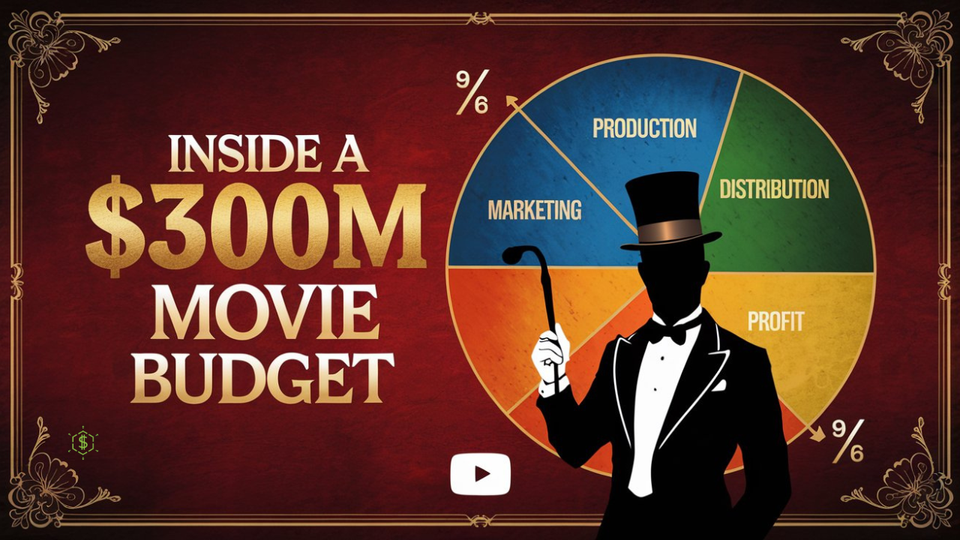Breaking Down the Finances of a $300 Million Movie: A Behind-the-Scenes Look at Hollywood Economics

Ever wondered how Hollywood spends $300 million on a blockbuster movie? We’re breaking down the fascinating finances behind these mega-productions. Discover how budgets, marketing, and profits intertwine in the world of cinema. 🎬💸
The True Cost of a $300 Million Blockbuster
Have you ever marveled at the grandeur of a Hollywood blockbuster and thought, How on earth did they spend $300 million on this? 🤔 Hollywood movies are often breathtaking spectacles, but behind the glamour is a meticulously planned budget that stretches across dozens of departments. From pre-production to post-production, every dollar serves a purpose.
In this blog, we’ll dissect where the money goes, how studios make it back, and the risks involved in producing high-stakes films. Stick around for an insider’s look into how Hollywood finances shape the movie industry.
Where Does the $300 Million Go?
1. Pre-Production: Laying the Groundwork
Before a single frame is shot, millions are poured into the pre-production phase. This stage involves:
- Script Development: Writers, rewrites, and intellectual property rights for adaptations often cost upwards of $5-10 million.
- Casting: Top-tier actors command salaries ranging from $10-50 million per film. Think of A-listers like Dwayne Johnson or Scarlett Johansson.
- Location Scouting and Set Design: Some productions spend millions just finding the perfect filming location, while elaborate set builds can run up to $20 million.
2. Production: Lights, Camera, Action!
The bulk of the budget is spent during filming. Key expenses include:
- Cast and Crew Salaries: With hundreds of professionals on set, labor costs can easily exceed $100 million.
- Visual Effects (VFX): Blockbusters like Avengers: Endgame allocate $50-100 million to cutting-edge CGI.
- Costumes and Props: Period dramas or sci-fi epics often have wardrobe and prop budgets of $10-20 million.
- On-Site Expenses: Equipment rentals, transportation, and catering can quietly drain millions from the budget.
3. Post-Production: Crafting the Final Product
Once filming wraps, the post-production phase polishes the raw footage into cinematic gold.
- Editing: Top-tier editors charge premiums, with costs often ranging from $5-10 million.
- Music: Original scores or licensing popular tracks can cost millions. Hans Zimmer’s soundtracks, for instance, don't come cheap.
- VFX Completion: Additional layers of CGI and sound effects ensure that explosions feel real and fantastical worlds come alive.
4. Marketing and Distribution: The Hidden Costs
Marketing budgets for Hollywood blockbusters often equal or even exceed production costs. A $300 million movie may spend another $150-200 million on:
- Trailers and Teasers: High-quality promotional videos cost millions to produce and distribute.
- Global Advertising Campaigns: From billboards in Los Angeles to TV spots in Tokyo, advertising is a global effort.
- Premieres and Press Tours: Flying the cast worldwide for red carpets and interviews adds significant expenses.
- Distribution: Shipping reels (or digital files) and negotiating deals with theaters require substantial investment.
How Do Studios Recoup Their Investments?
Box Office Revenue
Theatrical releases are the primary source of income for most films. However, theaters typically take 40-50% of ticket sales. A blockbuster earning $1 billion at the box office might only bring $500 million back to the studio.
Ancillary Revenue Streams
- Merchandising: Toys, apparel, and accessories linked to franchises like Star Wars generate billions.
- Streaming Rights: Platforms like Netflix and Disney+ pay handsomely for exclusive access to hit movies.
- Home Media Sales: Blu-rays and digital downloads still contribute significantly to revenue.
- Licensing: Secondary rights, such as theme park attractions or video games, add to the studio's earnings.
The Risks of Big-Budget Movies
1. Flops Are Expensive
When big-budget films fail, the losses can be catastrophic. John Carter and The Lone Ranger are infamous examples that resulted in hundreds of millions in losses.
2. External Factors
Pandemics, natural disasters, or political tensions can delay releases, driving up costs and impacting revenues.
3. Audience Tastes
A misjudged script or marketing strategy can alienate potential viewers, leaving studios struggling to break even.
Case Study: The Financial Journey of Avatar: The Way of Water
James Cameron’s long-awaited sequel was one of the most expensive films ever made, with an estimated budget of over $350 million. Let’s break it down:
- Production Costs: Over $250 million went into state-of-the-art motion capture and underwater filming technology.
- Marketing: Global campaigns likely exceeded $150 million.
- Revenue: With a global box office gross of over $2 billion, the film became a massive financial success, but its break-even point was rumored to be around $1 billion.
Why Do Studios Take the Risk?
Blockbusters often act as tentpoles for studios, supporting smaller, riskier films. A massive hit like Avengers funds indie projects or experimental films.
Call to Action: Learn More About Big Money in Entertainment
For more insights into the economics of entertainment and luxury lifestyles, explore other posts on HowToBuyMoney.blog.
- Related Articles:
Follow Us on Social Media for More Tips and Insights!
Stay updated with the latest in luxury, celebrity lifestyles, and big money moves by following us on:
Let’s uncover the world of wealth together! 🎥💰